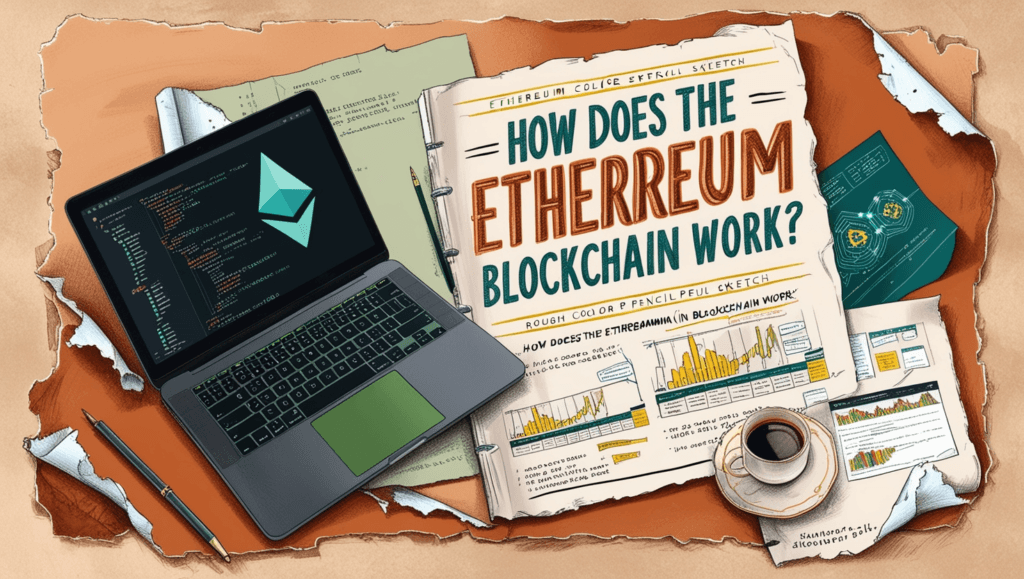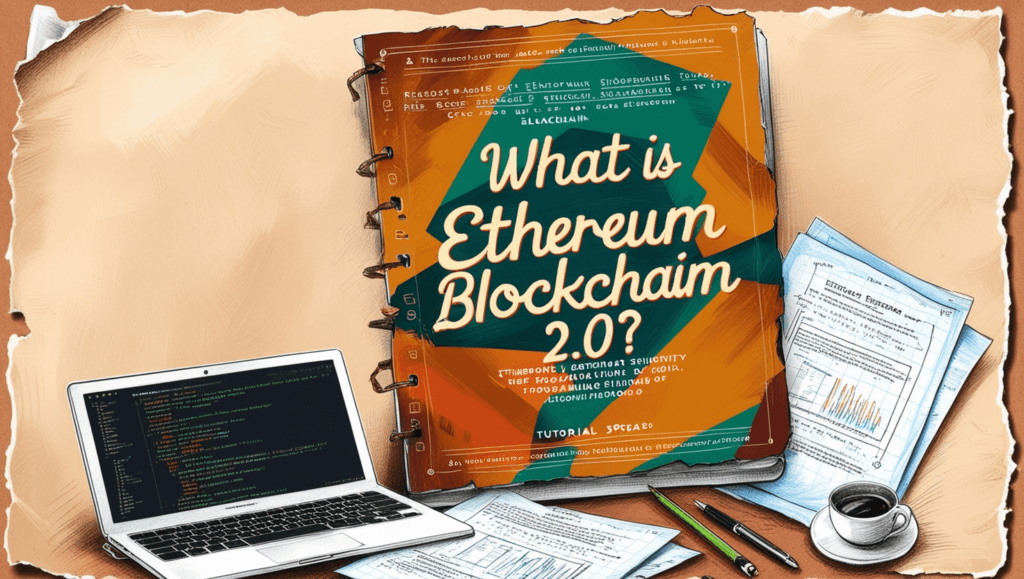Ethereum Blockchain : Ethereum is a word you’ve likely come across, especially if you’ve read about cryptocurrency. It’s a game-changer, paving the way for a new internet where users are in control. Think of Ethereum as the “supercomputer of the internet” — a massive, decentralized system where people can build apps, transfer money, and even create digital art (NFTs) without needing a middleman.
So let’s dive deep into the world of Ethereum: what it is, how it works, and why it’s so groundbreaking.
Table of Contents
Ethereum Basics: What Makes It Different from Bitcoin?
Ethereum is a blockchain-based platform created by a 19-year-old named Vitalik Buterin back in 2015. Vitalik saw that Bitcoin, while revolutionary, was limited mainly to being a form of digital money. Ethereum, on the other hand, introduced something new: programmable contracts.
With Ethereum, developers can create “smart contracts” that run on the blockchain itself. It’s like having a vending machine for agreements, where the machine only releases a snack if you put in the exact change and press a button. In the world of Ethereum, these contracts run without a company, server, or authority to manage them.
Quick Comparison of Ethereum and Bitcoin:
- Bitcoin: Mainly digital money or “store of value” (like gold).
- Ethereum: A platform for apps and contracts, and it has its currency, Ether (ETH), to power the network.
How Does the Ethereum Blockchain Work?
Ethereum is decentralized, which means it doesn’t rely on a central authority (like a bank or company) to operate. Instead, thousands of computers around the world, called “nodes,” work together to verify transactions and keep the system secure.

The currency of the Ethereum network is Ether (ETH), which acts like fuel, often called “gas.” Gas is what you pay in ETH to make any transaction on Ethereum, from sending funds to executing smart contracts. When you hear “gas fees are high,” that’s because the network is very popular, and the fee rises based on demand.
Ethereum works on blockchain technology, which is essentially a decentralized ledger. This means there’s no central authority like a bank or government overseeing transactions. Instead, it’s verified by a network of nodes (computers) around the world, each holding a copy of the blockchain. Here’s a basic rundown:
- Blocks and Transactions: Ethereum transactions are grouped into blocks. Each block is verified by nodes on the network and added to the chain of blocks, which is the blockchain itself.
- Proof of Stake: Ethereum initially used Proof of Work (PoW), like Bitcoin, but transitioned to Proof of Stake (PoS) with the Ethereum 2.0 upgrade. In PoS, validators are chosen based on the amount of cryptocurrency they hold and are willing to “stake” as collateral. This makes it much more energy-efficient and secure.
- Smart Contracts: A smart contract is essentially code that runs on the Ethereum blockchain. It automatically executes and enforces terms when certain conditions are met. Imagine a vending machine: when you insert money, it automatically delivers a product. Smart contracts work similarly but with complex terms.
The Magic of Smart Contracts
Smart contracts are one of the coolest things about Ethereum. Imagine a contract that enforces itself. For example, if you’re renting an apartment, a smart contract can automatically transfer your security deposit back to you after you move out, assuming all conditions are met. No need for a middleman, no need for extra paperwork.
The concept of smart contracts has led to Decentralized Finance (DeFi) — financial services without banks. DeFi applications let you lend, borrow, and even earn interest on your crypto without needing any traditional bank. That’s a huge part of what makes Ethereum so groundbreaking.
What Is Ethereum Used For? Real-Life Applications
Ethereum is often called the backbone of Web3, the new decentralized internet. Here’s how it’s making an impact:
1. Decentralized Finance (DeFi)
Ethereum is the foundation for DeFi, which aims to replace traditional banking with transparent, accessible services. You can lend, borrow, and earn interest on Ethereum-based platforms like Aave and Compound without needing a bank account or credit score.
2. NFTs and Digital Art
NFTs, or non-fungible tokens, exploded in popularity as unique digital assets that can represent anything from art to music to collectibles. Ethereum’s blockchain hosts most NFTs and proves the ownership of each token, making it possible for artists to sell their work directly to buyers.
3. DApps: Decentralized Applications
DApps are apps that don’t rely on a central server. Instead, they run on the blockchain, making them more secure and resistant to censorship. From games to social networks to finance, developers are building all kinds of DApps on Ethereum.
4. Token Creation
On Ethereum, you can create tokens that represent assets. Many new cryptocurrencies are built on the Ethereum network using its ERC-20 standard, making it easy to create and launch a new digital currency without needing a brand-new blockchain.
Understanding Gas Fees and Ethereum’s Transition to Ethereum 2.0
One downside to Ethereum is the gas fee. When the network gets busy, these fees can spike, making it costly to use Ethereum. But there’s good news: Ethereum is transitioning to a more efficient system with the Ethereum 2.0 upgrade.
What is Ethereum 2.0?
Ethereum 2.0 is a significant upgrade that aims to solve some of the biggest issues with the original Ethereum network, mainly around speed, cost, and energy use. Here are the big changes coming with Ethereum 2.0:

- Proof of Stake (PoS): Ethereum has moved from Proof of Work (PoW), where miners use powerful computers to secure the network, to Proof of Stake. In PoS, people lock up their Ether as “stake” to secure the network, making it less energy-intensive.
- Faster Transactions: Ethereum 2.0 can handle more transactions per second, making it faster and smoother to use.
- Cheaper Transactions: With PoS, gas fees are expected to lower, making Ethereum more affordable.
- Energy Efficiency: PoS uses far less electricity, making Ethereum greener and more sustainable.
The Ethereum Ecosystem: Gas Fees, ETH 2.0, and Layer 2 Solutions
Navigating Ethereum can sometimes feel overwhelming, especially with terms like gas fees and ETH 2.0 upgrades floating around. Here’s a quick breakdown:
- Gas Fees: Every time you make a transaction or interact with a smart contract on Ethereum, you pay a fee called gas. It’s like the fuel for your transaction. However, gas fees can be high, especially when the network is congested.
- Ethereum 2.0: This upgrade marks Ethereum’s transition from Proof of Work to Proof of Stake. The primary benefits include improved scalability, security, and environmental sustainability. Ethereum 2.0 has significantly lowered gas fees and increased transaction speeds.
- Layer 2 Solutions: Projects like Polygon and Arbitrum help reduce Ethereum’s load by handling transactions on a secondary layer, improving speed and reducing costs.
How to Get Started with Ethereum
If you’re interested in Ethereum, here’s how you can get started:
- Get a Digital Wallet: To hold ETH, you need a digital wallet. Wallets like MetaMask, Trust Wallet, and Ledger (a hardware wallet for extra security) are popular choices.
- Buy Ether (ETH): You can buy ETH on crypto exchanges like Coinbase, Binance, or Kraken. Make sure to transfer it to your personal wallet afterward for security.
- Explore the Ethereum Ecosystem: With ETH in your wallet, you can try out DeFi apps, buy NFTs, or simply hold onto it as an investment.
Future Possibilities: What’s Next for Ethereum?
Ethereum has already reshaped how people think about finance, art, and even the internet. But where is it headed next?
1. More Layer 2 Solutions
Ethereum’s main blockchain (Layer 1) can get crowded, leading to high fees and slow speeds. Layer 2 solutions, like Polygon and Optimism, help by taking some work off Ethereum’s hands. These projects operate on top of Ethereum to make transactions faster and cheaper.
2. Interoperability with Other Blockchains
Right now, Ethereum doesn’t play well with other blockchains like Bitcoin or Solana. But with future updates, developers hope to make Ethereum more compatible with other blockchains, opening up endless possibilities for cross-chain applications.
3. Ethereum in the Metaverse and Web3
Ethereum is positioned to be a major player in Web3, a decentralized internet where users control their own data. Many believe the Metaverse—where people can work, play, and socialize online—will be built on Ethereum’s blockchain.
Frequently Asked Questions About Ethereum
Q1: What’s the difference between Bitcoin and Ethereum?
Bitcoin is a digital currency or “store of value” while Ethereum is a full network for building apps, contracts, and digital assets.
Q2: Why are Ethereum’s gas fees so high?
Gas fees rise when the network is busy. Ethereum is working on solutions to reduce fees, like the Ethereum 2.0 upgrade and Layer 2 solutions.
Q3: Can I build my own app on Ethereum?
Yes, Ethereum is open-source, so developers can build their own decentralized applications, smart contracts, and NFTs on it.
Q4: Is Ethereum a safe investment?
Like all investments, Ethereum comes with risks. It’s volatile, but many believe its potential in DeFi, NFTs, and Web3 make it a valuable asset for the future.
Q5: How does Ethereum 2.0 affect me?
Ethereum 2.0 makes the network faster, cheaper, and eco-friendly. It’s a huge step forward for Ethereum’s usability and future growth.
Q6: Why are gas fees so high?
Gas fees rise when the network gets busy. But with Ethereum 2.0 and Layer 2 solutions, fees are expected to drop.
Q7: Is Ethereum safe to invest in?
Like any investment, Ethereum comes with risks. It’s more volatile than traditional investments, but its potential in DeFi, NFTs, and Web3 make it an exciting option for many.
Q8: What is the difference between Bitcoin and Ethereum?
Bitcoin is like digital gold—a store of value. Ethereum, on the other hand, is a whole network for building apps, handling contracts, and even creating new types of digital assets.


